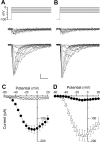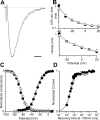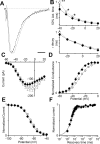Effects in neocortical neurons of mutations of the Na(v)1.2 Na+ channel causing benign familial neonatal-infantile seizures
- PMID: 17021166
- PMCID: PMC6674637
- DOI: 10.1523/JNEUROSCI.2476-06.2006
Effects in neocortical neurons of mutations of the Na(v)1.2 Na+ channel causing benign familial neonatal-infantile seizures
Abstract
Mutations of voltage-gated Na+ channels are the most common cause of familial epilepsy. Benign familial neonatal-infantile seizures (BFNIS) is an epileptic trait of the early infancy, and it is the only well characterized epileptic syndrome caused exclusively by mutations of Na(V)1.2 Na+ channels, but no functional studies of BFNIS mutations have been done. The comparative study of the functional effects and the elucidation of the pathogenic mechanisms of epileptogenic mutations is essential for designing targeted and effective therapies. However, the functional properties of Na+ channels and the effects of their mutations are very sensitive to the cell background and thus to the expression system used. We investigated the functional effects of four of the six BFNIS mutations identified (L1330F, L1563V, R223Q, and R1319Q) using as expression system transfected pyramidal and bipolar neocortical neurons in short primary cultures, which have small endogenous Na+ current and thus permit the selective study of transfected channels. The mutation L1330F caused a positive shift of the inactivation curve, and the mutation L1563V caused a negative shift of the activation curve, effects that are consistent with neuronal hyperexcitability. The mutations R223Q and R1319Q mainly caused positive shifts of both activation and inactivation curves, effects that cannot be directly associated with a specific modification of excitability. Using physiological stimuli in voltage-clamp experiments, we showed that these mutations increase both subthreshold and action Na+ currents, consistently with hyperexcitability. Thus, the pathogenic mechanism of BFNIS mutations is neuronal hyperexcitability caused by increased Na+ current.
Figures







References
-
- Avanzini G, Franceschetti S. Cellular biology of epileptogenesis. Lancet Neurol. 2003;2:33–42. - PubMed
-
- Baroudi G, Carbonneau E, Pouliot V, Chahine M. SCN5A mutation (T1620M) causing Brugada syndrome exhibits different phenotypes when expressed in Xenopus oocytes and mammalian cells. FEBS Lett. 2000;467:12–16. - PubMed
-
- Berkovic SF, Heron SE, Giordano L, Marini C, Guerrini R, Kaplan RE, Gambardella A, Steinlein OK, Grinton BE, Dean JT, Bordo L, Hodgson BL, Yamamoto T, Mulley JC, Zara F, Scheffer IE. Benign familial neonatal-infantile seizures: characterization of a new sodium channelopathy. Ann Neurol. 2004;55:550–557. - PubMed
-
- Bezanilla F. The voltage sensor in voltage-dependent ion channels. Physiol Rev. 2000;80:555–592. - PubMed
-
- Catterall WA. From ionic currents to molecular mechanisms: the structure and function of voltage-gated sodium channels. Neuron. 2000;26:13–25. - PubMed
Publication types
MeSH terms
Substances
LinkOut - more resources
Full Text Sources
Molecular Biology Databases
